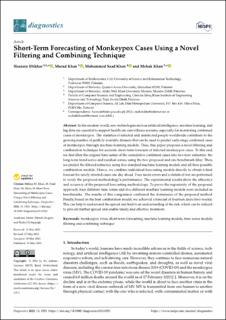| dc.description.abstract | : In the modern world, new technologies such as artificial intelligence, machine learning, and big data are essential to support healthcare surveillance systems, especially for monitoring confirmed cases of monkeypox. The statistics of infected and uninfected people worldwide contribute to the growing number of publicly available datasets that can be used to predict early-stage confirmed cases of monkeypox through machine-learning models. Thus, this paper proposes a novel filtering and combination technique for accurate short-term forecasts of infected monkeypox cases. To this end, we first filter the original time series of the cumulative confirmed cases into two new subseries: the long-term trend series and residual series, using the two proposed and one benchmark filter. Then, we predict the filtered subseries using five standard machine learning models and all their possible combination models. Hence, we combine individual forecasting models directly to obtain a final forecast for newly infected cases one day ahead. Four mean errors and a statistical test are performed to verify the proposed methodology‘s performance. The experimental results show the efficiency and accuracy of the proposed forecasting methodology. To prove the superiority of the proposed approach, four different time series and five different machine learning models were included as benchmarks. The results of this comparison confirmed the dominance of the proposed method. Finally, based on the best combination model, we achieved a forecast of fourteen days (two weeks). This can help to understand the spread and lead to an understanding of the risk, which can be utilized to prevent further spread and enable timely and effective treatment. | en_US |

